Notes on Scent
How do you smell?
Adam Jasper and Nadia Wagner
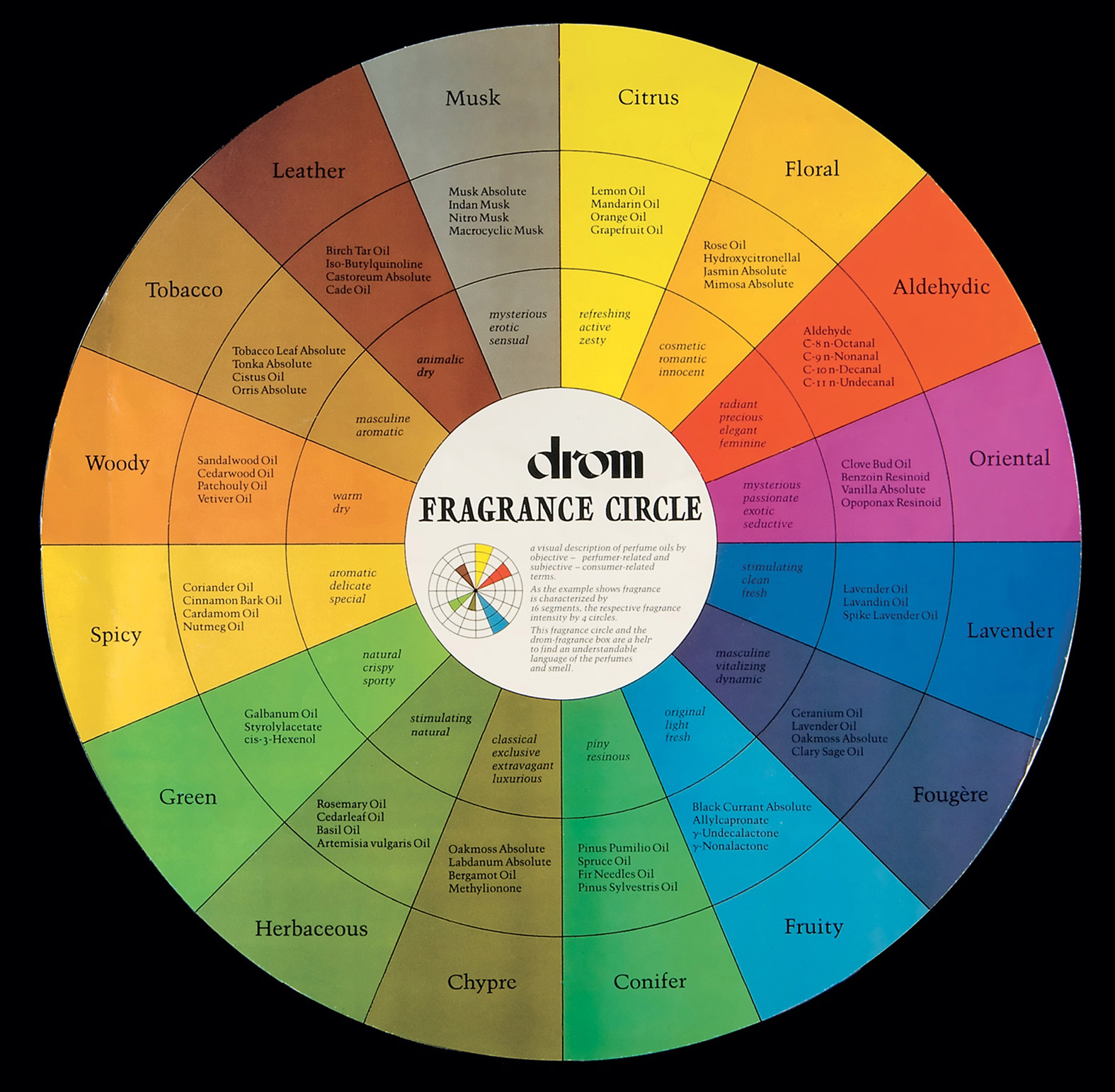
1.
It is commonly estimated that we can smell roughly ten thousand distinct scents, but no one has made a definitive claim regarding the number of smells an individual can differentiate. Unlike hearing and sight, whose mechanics and molecular biology have been exhaustively mapped in the course of the twentieth century, there is little agreement on how smell works.
2.
Our sense of smell is beyond doubt a tool of great precision. Strange, then, that in the history of Western philosophy it should be so little discussed, and so often dismissed as subjective. Smell has been held in low esteem since the height of the Enlightenment. When Condillac, in his Treatise on the Sensations (1754), imagined a statue that would be granted all the capacities of thinking and feeling one by one, smell was the first capability he bestowed upon it, because he held smell to be the most primitive of senses and the one that contributes least to the mind. Condillac maintained that, should his statue smell a rose, it would not thereby gain any concept of the rose as an entity distinct from itself. When it smells a rose, it simply exists within the sensation of the scent of a rose. Smell, this position implies, teaches us nothing about the outside world, but produces pleasant or unpleasant sensations that go on to determine what we desire, rather than what we know.
2.1
This demotion of smell has continued more or less uninterrupted, as demonstrated by the manner in which Septimus Piesse attempted to defend the utility of perfumes in his 1857 book The Art of Perfumery and Methods of Obtaining the Odors of Plants: “Of the five senses, that of smelling is the least valued, and, as a consequence, is the least tutored; but we must not conclude from this, our own act, that it is of insignificant importance to our welfare and happiness. By neglecting to tutor the olfactory nerve, we are constantly led to breathe impure air, and thus poison the body by neglecting the warning given at the gate of the lungs. Persons who use perfumes are more sensitive to the presence of a vitiated atmosphere than those who consider the faculty of smelling as an almost useless gift.”
A.
Chlorine (Cl2 at room temperature and pressure) is a pale green gas that was described by the soldiers that first encountered it in Ypres in 1915 as having a distinctive smell partway between pepper and pineapples. The characteristic acrid odor we associate with chlorine pools is not that of chlorine itself but of chloramine (NH2Cl), the product of a reaction between chlorine and an organic molecule. When a pool smells intensely of chloramine, it’s an indicator that the water is dirty, not clean, and the persistent smell that we carry for hours after a swim is the smell of free chlorine molecules reacting with our hair and skin. We become conscious of chlorine, in its peculiar chlorineness, at a concentration of three parts per million. At five parts per million it produces a choking sensation. At thirty it induces coughing and vomiting. At sixty it begins to corrode the lungs.
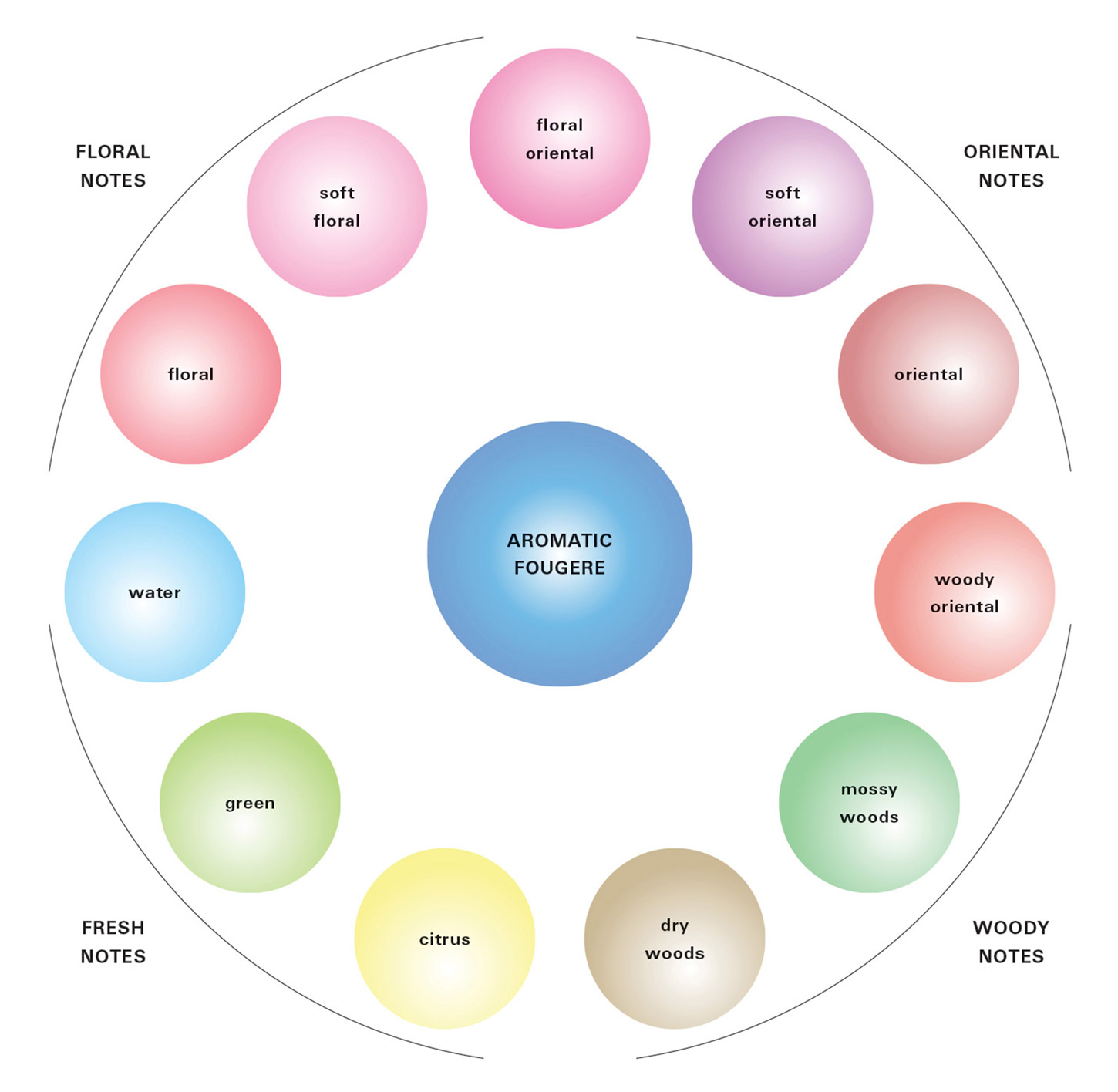
3.
Kant makes almost no reference to smell in the Critique of Judgment nor elsewhere in his writing on aesthetics. He does, however, discuss smell at length in his Reflexionen zur Anthropologie. There, he makes a curious distinction between the senses by which we as rational beings come to know things, and the senses that work on a more intuitive basis. Looking at things, hearing them, and even touching them require Wahrnehmung, or perception. But smelling things, like eating them, involves a sort of carnal knowledge, Einnehmung, or ingestion. By smelling things, we absorb them directly into our bodies, and consequently they provide what Kant otherwise only attributes to God: unmediated knowledge of the thing in itself. To prevent this from becoming a crisis for his epistemology, Kant argues that experiences of smell or taste are things that we are interested in, personally, and compromised by in both senses of the word. This prevents us from the sort of disinterested contemplation that aesthetic experience requires. Kant’s dogmatic exclusion of taste and smell from the aesthetic has either been reproduced without question or thrown out of court (see Frank Sibley’s essay “Tastes, Smells, and Aesthetics”), but no one seems to have considered that maybe he was half-right. Smell is deeply connected with the unconscious, divorced from representation, and consequently in some respects more primal than the other senses. It indicates a royal road to our animal and emotional being, offering a way of thinking, or at least of drawing conclusions, that is not conceptual but intuitive.
3.1
Smells have two qualities that make them ill-suited to the Enlightenment project of establishing a firm foundation for our knowledge of the world. First, they do not persist. Most smells are fleeting—the smell of violets (methyl ionone) is famous among perfumers for persisting for only about half the duration of an inhalation before it becomes imperceptible. Other scents are more persistent, but even the most penetrating perfume becomes undetectable to the wearer after a short period of time.
3.2
Second, as Kant writes in Reflexionen zur Anthropologie, “all the senses have their own descriptive vocabularies, e.g. for sight, there is red, green, and yellow, and for taste there is sweet and sour, etc. But the sense of smell can have no descriptive vocabulary of its own. Rather, we borrow our adjectives from the other senses, so that it smells sour, or has a smell like roses or cloves or musk. They are all, however, terms drawn from other senses. Consequently, we cannot describe our sense of smell” (our translation).
3.2.1
Kant’s observation does not seem to be a limitation of his Baltic Sea dialect. There are also no words in the English language that are exclusively devoted to describing a smell. All the other senses have a specific vocabulary that is part of everyday speech and in no way technical (bright, loud, hard, soft, smooth, bitter, etc). Smell proceeds entirely via euphemism. Typical words for describing citrus scents include fruity, refreshing, sweet, sharp. “Fruity” is derived from a noun. “Refreshing” is stolen from an affect. “Sweet” belongs to taste. “Sharp” to touch. The word citrus, in toto, is useless for anyone who has not smelt citrus already, and none of the descriptive words belong to the sense of smell except in a metaphorical sense.
B.
A curious piece of trivia claims that all medical anesthetics are olfactants, that is, they have a peculiar and identifiable smell. From chloroform on, synthetic molecules used to knock you out (things you couldn’t possibly have evolved to be able to experience) have distinct odors.
4.
Freud said that “wishes are immortal.” In this respect, smells and wishes are the same. The passage of time, which rots and corrodes the content of visual memory, has no measurable impact on the olfactory memory (Trygg Engen, “Remembering Odors and Their Names,” American Scientist, no. 75, 1987). On the condition that a smell is linked to an emotionally significant episode, the ability of specific smells to trigger episodic memories is immortal (the Proust Effect). Strangely, we are terrible at recalling the impression of smells—nearly as bad as we are at remembering physical pain. It’s easy to recall the shape and color of a lemon, but almost impossible to conjure up its absent scent.
C.
Is the sense of smell really subjective? Zookeepers have long noted that the smell of tiger’s urine resembles fragrant basmati rice. It was only in the course of the 1980s that Indian biologists realized that the same molecule is active in both—2 acetyl-1-pyrroline. (R. L. Brahmachary, M. P. Sarkar, & J. Dutta, “The Aroma of Rice ... and Tiger,” Nature, vol. 344, no. 6261, p. 26.) Furthermore, it’s been noted that we can detect certain pyrazines, such as 2-isobutyl-3-methoxypyrazine—which is found in peas and paprika—at a concentration of 1 part in 500,000 million, that is, virtually molecule by molecule.
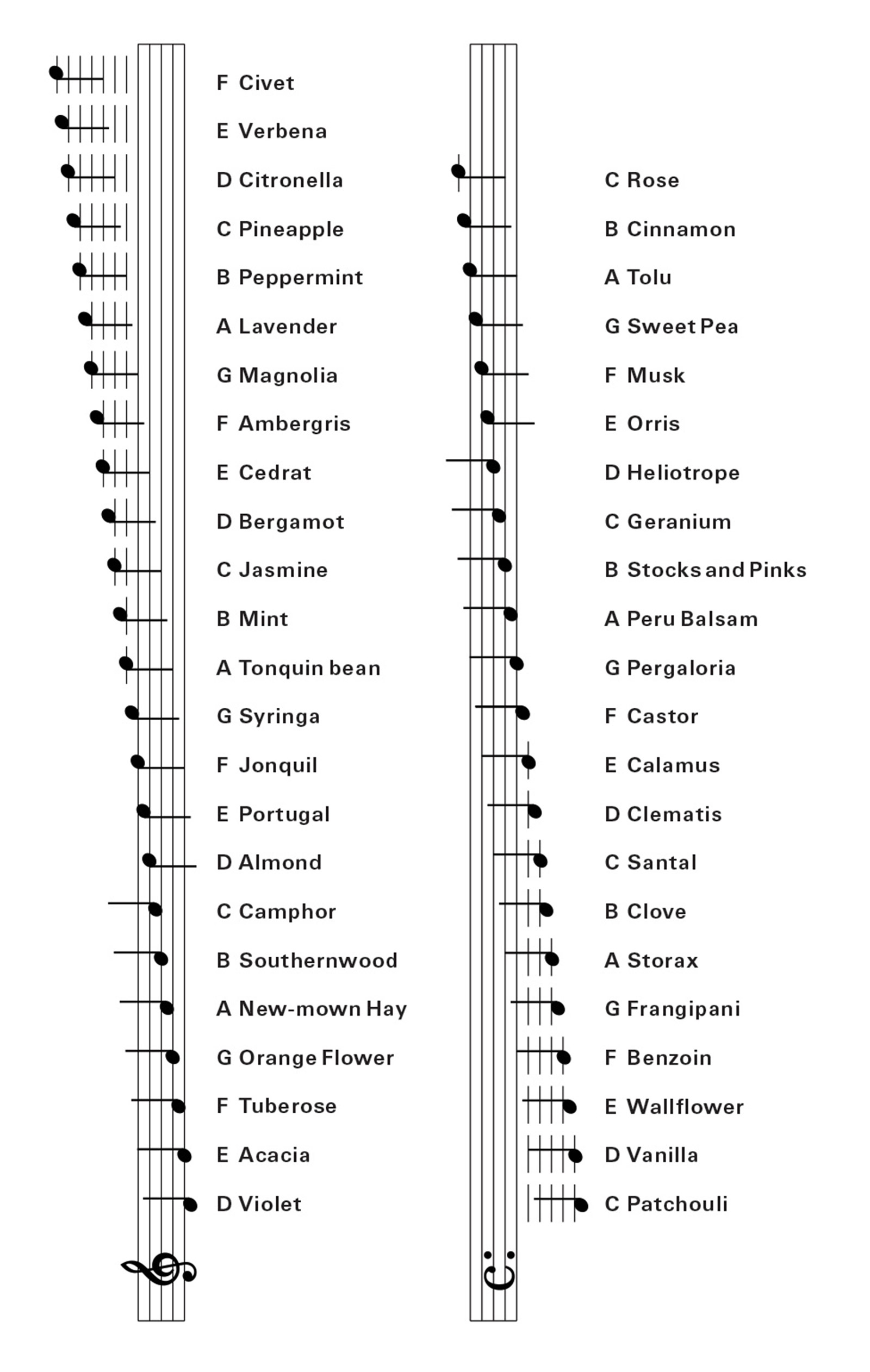
5.
The olfactory bulb in humans is relatively small compared to, say, a white-eared opossum, a West European hedgehog, a polar bear, or a domestic dog, especially when taken in proportion to the size of the brain. But the number of human genes that encode scent has turned out to be unexpectedly large. According to Linda B. Buck and Richard Axel’s research, about one thousand genes code for proteins that are only expressed in the olfactory epithelium. This means that roughly 3 percent of the human genome is devoted to the olfactory system. That’s an enormous share.
5.1
The olfactory bulb feeds directly into the limbic system, the seat of both long-term memory and the emotions. The results of smelling are processed here, and loaded with associations, before they even reach the upper cortex, where language is composed. This is unlike the sense of sight, in which knowing and naming are intimately interconnected activities. In a peculiar way, smelling short-circuits conscious thoughts. It bonds to memory and emotion before it subjects itself to concepts, and emerges as already a part of the bodily unconscious.
5.2
Although there has been substantial research on the olfactory bulb, olfaction is dwarfed by the other senses in the amount of research committed to it, and ignored in undergraduate studies (a 2008 textbook on cognitive neuroscience offers a chapter on sight, another on touch, but exactly two sentences on smell). This might have something to do with the following: no one agrees on how smell works. Although the problems posed by hearing and sight on the cellular level were to a large degree cracked by the 1950s and 1960s, there is still no consensus on how a molecule of olfactant entering the nose brings a single neuron to fire.
5.3
In 1996, Luca Turin—a research biologist and well-known perfume reviewer—resurrected an exotic theory of the sense of smell that had first been mooted and dismissed in the 1950s. It suggests that the smell of a compound is not dependent on the shape of the molecule (although this is the standard hypothesis, as “lock and key” ligand-binding is the mechanism by which most chemical signaling within the brain takes place, as well as the way in which the immune system functions). Rather, Turin solves the combinatorial problem of smell by arguing that embedded in the cell membrane is a kind of electron-tunneling spectrograph, and so the smell of a molecule is dependent upon its chief vibrational resonance.
D.
The port wine magnolia has small purple and white inflorescences that smell distinctly like nail polish remover (acetone) and wine jujubes. The scent is strong, sweet, and slightly nauseating. Other magnolias smell like citrus. Not exactly like citrus, but somewhat like citrus. Is acetone a pollutant that is actually found in cheap port wine?
6.
The relationship between smell, long-term memory, and emotion is not a trivial one, and it’s not meaningless to say that they’re all one thing. Everyone knows that smell evokes strong memories, but the relationship works both ways. The olfactory bulb is the only part of the brain that continues to grow throughout our lives, and constantly generates new neurons (Buck & Axel won a Nobel prize for figuring this out). The ability to recognize common smells is now used as a diagnostic tool in identifying neurodegenerative diseases. People without memory—Alzheimer’s patients—have massively reduced sensitivity to smell.
E.
Real musk is obtained from the dried gland of a wild male deer, and fresh from the wild it has a repulsive smell. Harvesting musk involves hanging out in forests during mating season with a high-powered rifle, shooting a medium-large mammal, cutting out a small gland, and then taking and preparing that gland for a luxury product. Hunters can’t tell whether the deer in their sights is a buck or a doe, and consequently half of the animals they shoot are the wrong sex. That’s one reason for synthetic musks. Another is that real musk is a mélange of chemicals that will cause some wearers to break out in hives. The first synthetic variant—Musk Xylol—was produced in 1888, and as the industry bible by Steffen Arctander notes, it is a close relative of trinitrotoluene, or TNT. Attempts to synthesize Musk Xylol in commercial quantities have been responsible for serious explosions in fragrance laboratories, and the death of more than a few fragrancers.
6.1
It is as if, when chemistry evolved out of alchemy to become an Enlightenment science, smell was left behind. Appropriately, the perfumer behaves more as a member of a medieval guild than as part of a contemporary scientific discipline. Alchemists guarded their mysteries, whereas chemistry is based on peer-review and the broadest possible dissemination of results. Perfumers are likewise notoriously secretive about their ingredients, even though the field involves the mass production of tons of refined chemical products. They are even loath to talk about how they arrange their fragrance libraries (this seemingly innocent question was in fact the impetus for this text). There is a legal reason for this: it’s not possible to patent a scent. You can patent the individual synthetic molecules that might be used in a scent, but you can’t patent what something smells like in the same way that you can patent the way in which a product looks and feels. Knockoff perfumes are prosecuted for copying the packaging of the original, not for smelling identical. As a result, perfumers are particularly clandestine about what’s in their bottles. The other reason for their secretiveness is that, even if they want to talk about what they are doing, they seem to find it pretty difficult.
6.2
Systems of smell resemble medieval bestiaries that have swollen in population without gaining in order. Aristotle classified smells into five categories. Linnaeus’s system contained seven categories, but by the early twentieth century Zwaardemaker’s had swollen to nine. Gerbelaud’s system from the 1950s encompassed forty-five categories, and a decade later Arctander’s included eighty-eight separate groups. Even more striking than the increasing complexity of the proposed systems is the parallel proliferation in the taxonomies themselves. A comprehensive taxonomy of taxonomies is hardly possible, but we can enumerate a few.
6.3
Crocker and Henderson’s 1927 model derives many of its terms from Zwaardemaker’s model of 1895, which itself draws from Carl Linnaeus’s original taxonomy of 1756. According to Crocker and Henderson’s ingenious scheme, each odor can be considered in terms of the extent to which it is fragrant, acid, burnt, or caprylic, each on a scale of 1 to 8. Thus, vanillin has an odor of 7122. Unfortunately, there is often disagreement as to the precise score to give a scent on each of its characteristics, although Crocker and Henderson do attempt to provide a structured language for comparing scents.
6.4
Some industrial scent manufacturers arrange smells into a sort of “color wheel” in order to describe them. But this is a weak analogy, as smells, unlike colors, do not naturally form a continuous spectrum. The Drom spectral wheel, for instance, implausibly places citrus directly next to musk, but spatially opposite to “fruity” scents. Different wheels have been proposed, but their insufficiency is highlighted by their proliferation.
6.5
Even fragrance wheels specific to the perfume industry (such as Michael Edwards’s 1983 version) are not designed as an objective tool for the fragrancers, but as a marketing guide for clients. To make matters worse, it seems that we are particularly susceptible to being suckered when we are told what we “ought” to be smelling. As Trygg Engen notes: “The associative strength of an odor-name pair is weak and asymmetric and is easily influenced by the verbal factor” (p. 502). In other words, if someone offers you a bad synthetic frambinone, and tells you it’s strawberry, you’ll believe them, and if they ask you to sniff onion and tell you it’s garlic, you’ll notice nothing amiss.
6.6
There have been more inventive attempts to taxonomize odor. In the nineteenth century, Septimus Piesse arranged smell on a musical scale to show how harmonious perfumes could be composed, a better (more multidimensional) approach than a linear spectrum. He was the first to apply the term note to a distinctive odor, as well as introducing the terms chord, harmony, and progression, all metaphors that are still current in the perfume industry. Piesse proposed that “sounds appear to influence the olfactory nerves in certain definite degrees,” and that “there are octaves in odors like octaves in music.” Piesse took his model quite literally. According to his theory, a harmonious fragrance can be composed by bringing together those odor notes that correspond to harmonious musical chords. Conversely, discord, a cacophony of smells, is the result of combining olfactory notes that would produce discordant sounds if played musically together. In his invention, Piesse resembles Des Esseintes in Joris-Karl Huysmans’s Against Nature, the great novel of dandyism, who composes for himself a “taste symphony” by assigning a different note to each liquor. Via this artifice, Huysmans’s character could play himself his favorite refrains from classical music by sequentially tasting various spirits.
6.7
Perhaps one of the most interesting models is the Henning Odor Prism, or Henning Olfactory Prism (1915–1916), a triangular prism that resolves the problem of how to visually depict the complex variability of smells by presenting them as points on the surface of a three-dimensional model. The prism has six apexes and five faces, and allows for any smell to be described in terms of the six categories: flowery/fruity/putrid/spicy/burnt/resinous. This would not be a substantial addition to extant theories, except that Henning goes on to argue that all smells can be described as being on the surface of the prism, but not within it. Therefore, a smell cannot be spicy, burnt and resinous as well as being putrid, and likewise, a fruity, flowery, putrid and spicy odor cannot exist. In making assertions of this kind, the Henning prism is at least putatively falsifiable, unlike most other smell models. This is no small virtue.
6.7.1
The Henning Prism becomes more interesting when one notes the sub-groupings that the on-the-surface rule implies. Cover two of the terms at a time, and look again at the set of characteristics flowery/putrid/spicy/burnt versus the set fruity/putrid/burnt/resinous. It could be argued that both groups have enough terms to adequately describe any smell, and there is a risk of that, but that isn’t what Henning intended. What is it about these two groups that make them mutually exclusive? Certainly the flowery/fruity/spicy/resinous—the general realm of attractive smells—can coexist, but not together with the putrid and burnt. The putrid and the burnt both mark out forms of decomposition. The putrid indicates metabolic decay carried out by simple life forms, whereas the burnt is the rather more chaotic decay caused by heat (both processes are marked by increasing variety but reducing complexity in the organic molecules present). Whereas flowery and fruity scents may, in their freshness, have much in common, according to the Henning prism they differentiate themselves from each other in their odor profile during decomposition. Also, it is noteworthy that the flowery/fruity/putrid (less stable) and the spicy/burnt/resinous (less volatile) take opposite ends of the Henning Prism.
6.7.2
Intriguingly, the Henning Prism also suggests the possibility of charting “smell trajectories,” that is, the characteristic changes in smell as a perfume’s volatile top note lifts to reveal its middle and base note, as a fruit ripens, or as an organic product undergoes metabolic decomposition. By what habitual route does an unripe peach slowly lose its spicy, flowery characteristics to sweeten into an odor more fruity and perhaps more resinous? And via what path does this scent become putrid as the peach begins to rot? Is it curved, or straight?
6.7.3
Henning attempted to relate different chemical groups to the various sections of his prism, noting, for instance, that the category of the putrid is marked by volatile sulphides. Unfortunately, while some molecules might have predictable characteristics, like a bad grammatical model, there are nearly as many exceptions to each category as well-behaved instances that fit the rules.
F.
Ambergris is another highly valued ingredient in perfumes. It is made of a sort of fatty hairball coughed up by a sperm whale that then floats upon the surface of the ocean. Over time it darkens to black, and its scent mellows until it becomes what is described as a “soft, suave, dry-mossy, musty and seaweed-like fragrance that is extremely difficult to duplicate with complete fidelity.” The trade in ambergris is now banned, and a wholly synthetic version of the scent, Ambroxan, is sold in its place.
6.8
In 1951, Dr. Paul Jellinek proposed a new scheme for the classification of scents. Although a professional perfumer, his system (which has been restated in The Psychological Basis of Perfumery, 4th Edition, 1997) has the virtue of attempting a degree of generality. The schema, however, is tendentious in the worst sense. As Jellinek held that the sense of smell is enthralled by sexuality, he arranges all odors on a scale based on their purported psychological effect. One axis connects the erogenic to the anti-erogenic, another axis runs from the narcotic to the stimulating. Following Jellinek, cheesy smells are both highly erogenic and slightly stimulating, whereas fruity smells are anti-erogenic and somewhat narcotic. The problem, of course, is that as soon as one questions the psychological model behind the classification, the schema collapses. And in spite of all the enthusiasm about pheromones, they remain more or less mysterious. It’s also not advisable to buy synthetic pheromones from dispensing machines in toilets, as androstenones, the closest pheromones to humans that have been extensively synthesized, are from the family porcine. The only mammals that you are likely to arouse irresistibly are pigs.
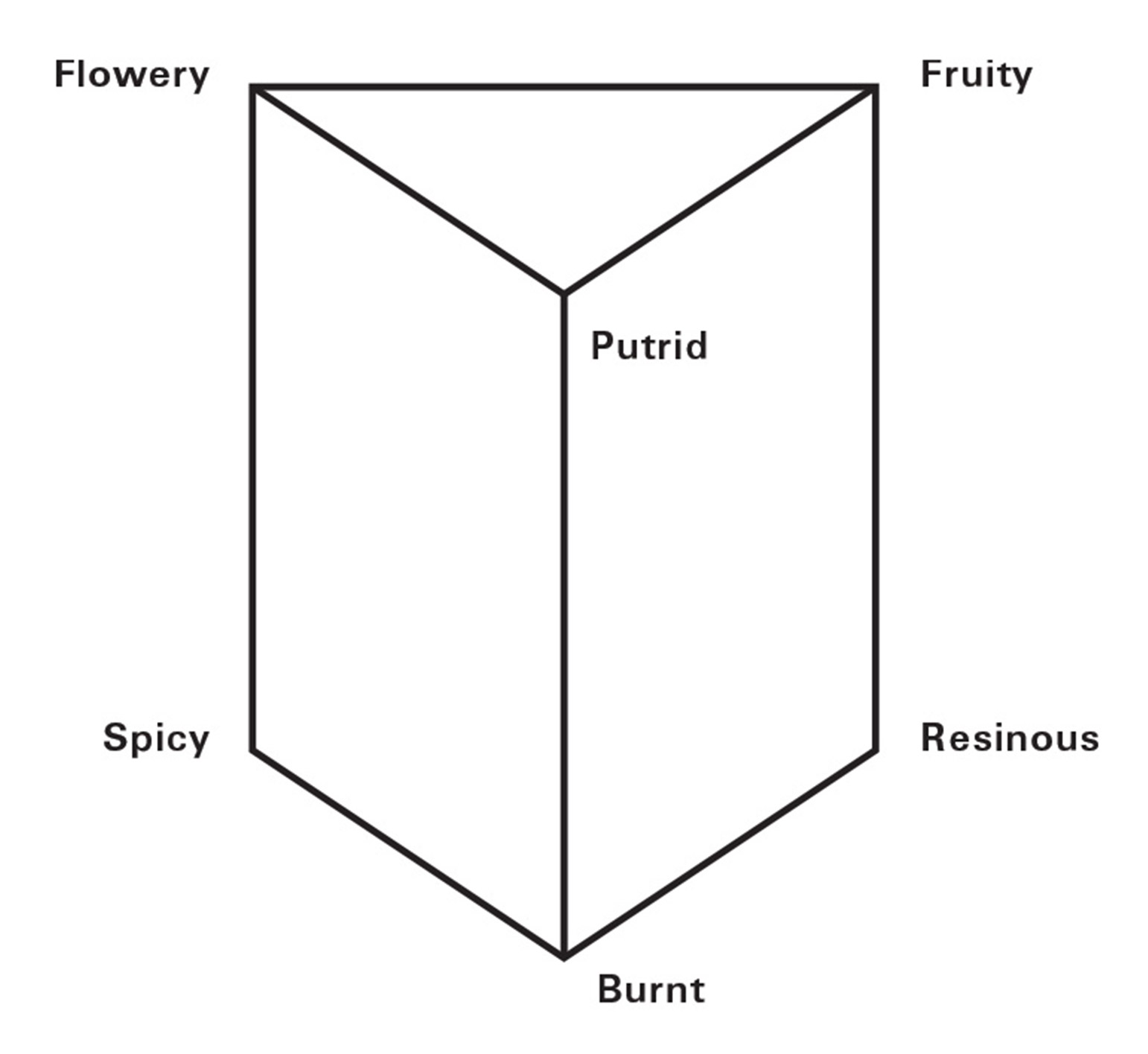
7.
Luca Turin’s thesis of the vibrational basis of smell has come up against entrenched opposition from the scientific establishment. Perhaps, here again, it is the enchantment of the diagram that is responsible, for should his argument prove to be correct, the wire-frame and space-filling molecular models that mesmerize fragrance designers worldwide would have precious little relevance in predicting how a chemical will actually smell. The thousands of line drawings of organic molecules that fill fragrance textbooks will turn out to be as much a fetish as Piesse’s musical scale, because we have been studying the wrong characteristics.
G.
Oak moss has a particularly wonderful smell—neither vegetable nor animal, but richly aromatic. The moss grows only on oak trees, and only in the most established and ancient woods. For a very long time, the majority of it was harvested in Yugoslavia. However, it soaks up radioactive waste more effectively than just about any other life form, and ever since the Chernobyl disaster in the Ukraine, it has been exceedingly rare and expensive.
8.
In conclusion, smell is not subjective; rather, it is simply very hard to communicate objectively, that is, to talk about and achieve any sort of consensus. One possibility would be to unwind the “color wheel” model, and ask how many dimensions it would have to incorporate in order that all its observable contradictions disappear. Much like experimental versions of Mendeleev’s original periodic table, there are interesting possibilities for new spatial models for representing scents. Perhaps future models of smell will have to address similar orders of complexity, and the solution just hasn’t been drawn up yet. Alternatively, there may simply be no way to represent visually the variability presented by scents.
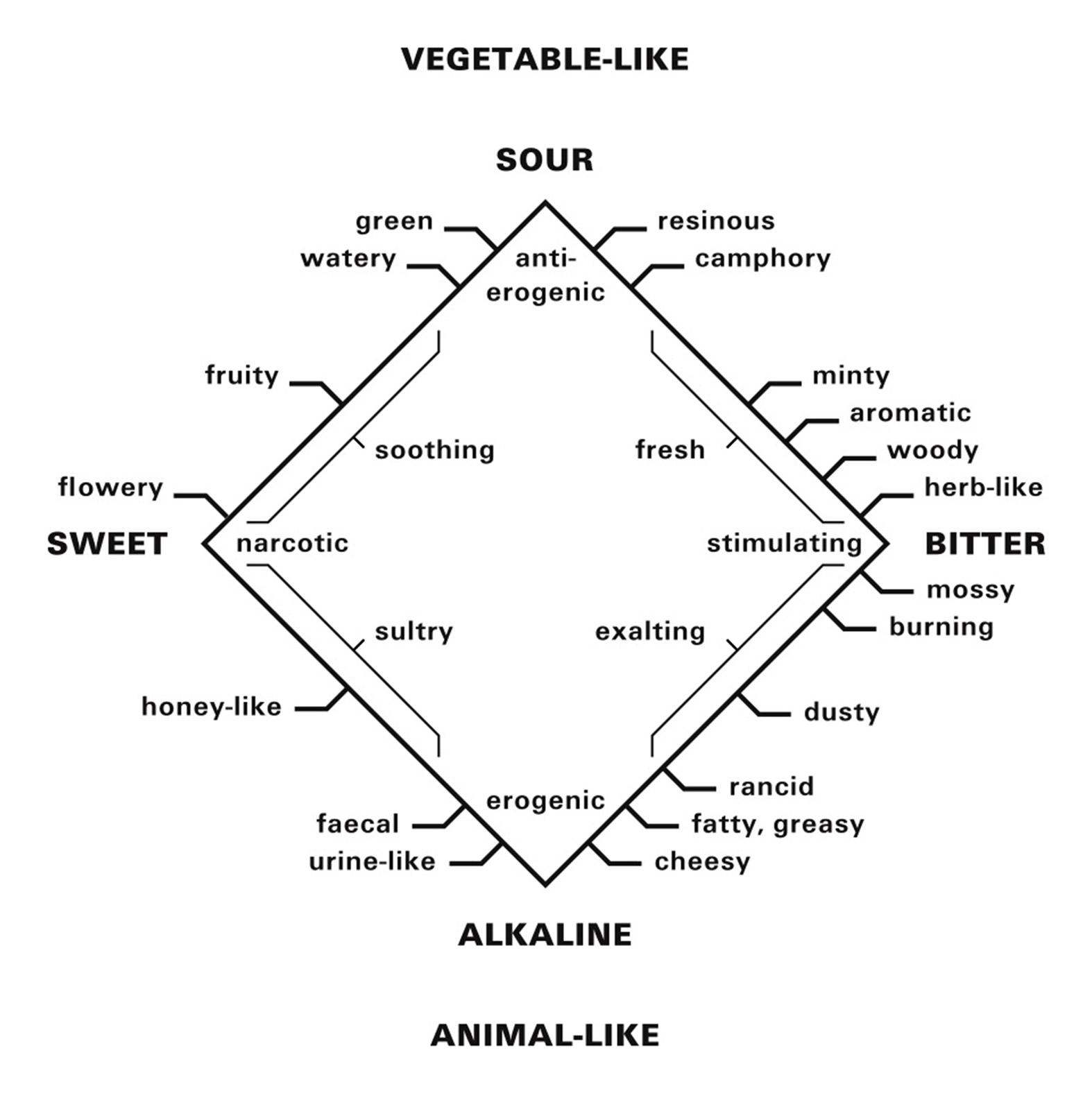
9.
In Civilization and its Discontents, Freud tells an originary myth, in which Man goes from walking on all fours to standing erect. As he does so, the genitals are exposed, the sense of sight is privileged, and the sense of smell is denigrated. Whether or not the story refers to an actual historical event doesn’t matter; Freud’s point is that somewhere in our development, we learn shame for what has become the spectacle of shit and lose the capacity to smell it with any finesse. However, there’s a simpler physical explanation for why walking on two legs might lead to a demotion for the sense of smell: olfactants are heavier than air, and consequently they fall to the ground. If you want to make a map of how your room smells, you need to get down on your hands and knees.
10.
And finally, how do professional perfumers arrange their smells? Alphabetically, of course.
Adam Jasper recently completed a dissertation on minor aesthetic categories. He is an occasional contributor to Frieze, Art Review, and Art & Australia, among others.
Nadia Wagner teaches design at the College of Fine Arts, University of New South Wales, Sydney. She is currently researching the role of smell in design and architecture.
Spotted an error? Email us at corrections at cabinetmagazine dot org.
If you’ve enjoyed the free articles that we offer on our site, please consider subscribing to our nonprofit magazine. You get twelve online issues and unlimited access to all our archives.